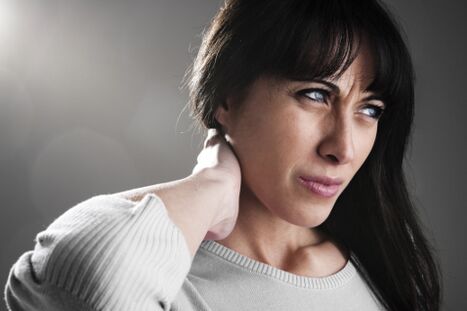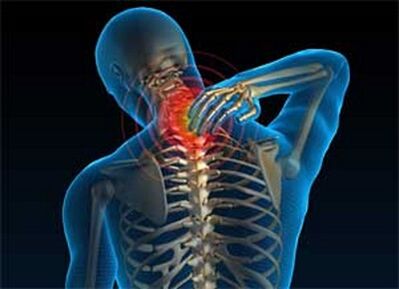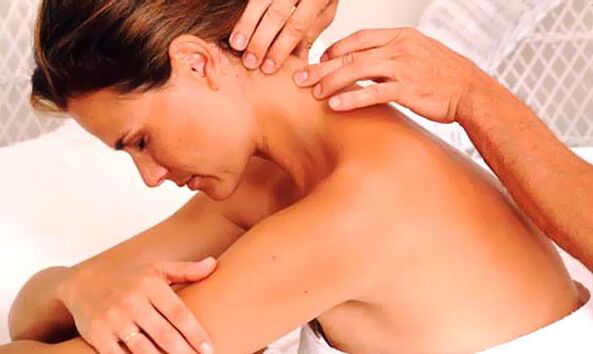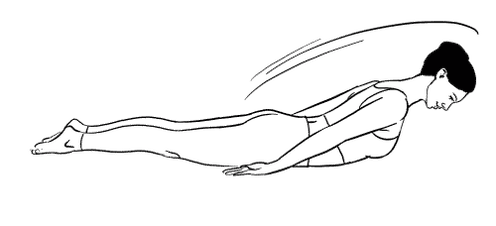
It is very sad to understand, but at the moment almost all the people who have reached 25. The anniversary suffers from the osteochondrose of the cervical vertebrae.In the cervical vertebrae, this disease is most often, compared to other spinal departments.So this topic is very relevant in the modern world.
We'll tell you why osteochondrose appears, how it manifests and how to act.
Consider and which medications operate more efficiently and provide an example of the necessary exercises for the treatment of this disease.
Osteochondrosis of cervix is the degenerative process in interfaced discs, which significantly reduces their height in the Grlić spine.This leads to changes not only in the interfaced discs, but also in the vertebra and joints of this department.
Causes of osteochondrose Regions of the Grlić registrar
Factors will be listed immediately, as a result of the pressure on the spine of the cervix.In order to compensate for the neck muscles trying to transfer excess loads, and as a result there is spasm and circulation disorders in this area, which means degenerative changes.
Causes of cervical osteochondrosis in men and women (factors that affect the development of osteochondrose of the cervical spine):
- a violation of the position or curvature of the spine;
- Excess weight;
- Hypodynamia is a sitting way of life (for example, sitting working with the driver, employees in the office);
- Trauma or spine damage;
- Point in metabolism:
- Regular physical activity;
- stress or unstable psycho -emotional state;
- The physical state of the muscle is not sufficiently developed;
- It is inherited from parents;
- Constantly holding the phone to the shoulder;
- Development of anomalies in the Grlić spine.

The causes of osteochondrosis of cervix are only worsened without a timely medical intervention.
Development of cervical osteochondrosis
The degree of osteochondrosis is not at all his phase.It is determined based on the patient's words and the general clinical image.We will note ourselves with stages later.
So:
First degree
Minimum events, the patient complains of weak pain in the cervical region, which intensifies if you turn your head.When examined, it can be determined that cervical muscles are slightly tense.
Second degree
The pain in the spine of cervix is becoming much more intense.It can be expanded to shoulders and hands.This explains the fact that the height of the interverter disc is reduced and the roots of nerves violate.Pain grows when a person leans or turns his head.The patient is worried about headaches, constant weaknesses and even declining performance.
Third degree
Explicit symptoms of osteochondrosis are manifested stronger and are regularly present.Common pain in hand or shoulder can cause the nobility of the upper limbs and weakening muscles due to the formation of intervertebral hernia.Permanent weakness and dizziness.On the examination, it can be discovered that the cervical spine becomes less mobile and pain during the feeling of this site.
Fourth degree
The interverter disc is completely destroyed, which now replaces the connective tissue.Dizziness is amplified, the noise appears in the ears, coordination is disturbed, because it affects the vertebra artery to cerebellum and the occipital brain.
Deterioration of cervical osteochondorosis is extremely dangerous due to the small size of this department and great importance for the entire core apparatus.The smallest inspection of vertebrate can lead to compression of the most important nerve endings.And educated osteophytes at a later stage will lead to even worst consequences for blood vessels and nerves.The negative result can be a hernia or protrusion of the spine, which is why the nerve spine is swollen even after that inflammation.As complications of cervical osteochondrose, this is the compression of spinal cord.The defeat extends not only on the neck and head, but also in the limbs (in the beginning in the upper part).
What are the symptoms of cervical osteochondrose?
The osteochondrosis of the spine of cervix is very different in their symptoms from such a disease in other parts of the spine.This can be explained by the fact that in this part of the spinal column, very small distance between vertebrae, which means that the smallest pathology of nerve endings and spinal cords.

The most common symptoms of osteochondrose cervical and thoracic spine:
- Pain.It can also be localized in the neck and on the back of the head, in the shoulder or even in hand.The pain in the occipital part of the head is caused by muscle cramps that are attached to the door to the occipital bone and cause blood circulation disorders.Shoulder sensations in the shoulder or upper-gained earnings occur due to attracting nerve endings that supply the muscles of these parts of the body.
- Weakness in their hands.The result is the damage to the nerve responsible for movement, innervating arm muscles.
- A reduction in the sensitivity of the hand.It seems when the process hurts a nerve, which provides sensitivity in the skin of the upper limbs.
- The movement in the thunder spine in the Grlić spine is limited, crumb when you move your neck.It is published by the fact that the height of the intervertebral disk decreases, bone growth appear on the body of vertebral and small joints in the intervertebral space are affected.
Symptoms of cervical osteochondrose arising in the brain are expressed by weakness, dizziness and damaged coordination.These symptoms appear when the vertebrate artery is involved in the process, which passes through its own channel located in the holes of the transverse processes of cervical vertebrae.Due to the development of cervical osteochondorosis, the rollers are displaced vertebrae, jerks, blood circulation in the arteries is deteriorating, leading to deterioration in blood supply to the occipital area of the brain and brain.
- Language arminess, hearing loss and vision.Symptoms of advanced form of cervical osteochondrosis, when blood circulation in the occipital part of the brain, cerebellum and the hull are strongly exacerbated.
The lump in the throat with osteochondrose of the cervical spine is very common and is not very specific.Many people take it for a cold symptom and fight with warmth, rinse and medication.But these are not those methods of fighting, so no relief appear.The most common strengthening discomfort occurs at night, and patients creep in fear that the next part of the air cannot be inhaled.
The main symptoms of cervical osteochondrosis are pain, weakness in the hands, movement limit in the cervical region, dizziness, reduced coordination and tension.
Such symptoms of cervical osteochondrose in women and men should not be ignored.When they appear, you must immediately visit neurology.
Odbods cervical osteochondrose
Main diagnostic methods:
- X -Ray cervical spine.Not a specially informative way, especially in the advanced stage of osteochondrose.
- Computer Tomography.It shows the relocations in vertebrates, but it is difficult to set the presence and size of intervertebral hernia, as well as determine the pressure of the rain on the spinal cord.
- Magnetic resonanceCamography.The most common informative way.You cannot look at not only a bone structure, but also intervebrebral discs, the presence of Hernie, its size and direction of growth.
- Duplex scanning blood vessels.It is applied if there is any doubt that blood circulation is disturbed in vertebral arteries.Using this method, it is enough to simply determine the changes in blood circulation speed and quickly identify obstacles on its way.
X -Ray Stages Cervical Osteochondrose:
Phase I - Small changes in the schedule of vertebrae, the cervical lordosis spine is smoothed out;
Phase - instability between vertebral, one spine against another shift, Thoros is not excluded - rotation of the vertebrae around the axis, the amount of the intervertebral disk reduced slightly;
Phase III - General drop in height between intervebrebral disks is, the arthrosis of interfere joints and osteophytes, intervertebral holes and the spinal canal are reduced, where the spinal cord is set;
STAGE IV - The amount of the intervertebral disk is significantly reduced, arthritis of intervelling compounds, very large osteophytes are actively developing, intervertal holes and the spinal channel, with the development of my elect baths, are very reduced.
Cervical osteochondrose treatment

The main methods of cervical osteochondrosis treatment are medicinal drugs, physiotherapy, massage of the core-muscle zone and very efficient therapy gymnastics.
Below are groups of drugs used in the treatment of osteochondrose cervix:
- Not -steroidal anti -inflammatory drugs - helping help with pain, mitigate an aseptic inflammation of compounds and edema injured nerve roots;
- B vitamins - to adapt metabolicism in nerve tissues;
- Medications that normalize the rheological properties of blood and blood circulation;
- Chondroprotectors - drugs that return the cartilage on the damaged interverter holder;
- Musorelaxans are medications that eliminate muscle cramps.
Attention!These medications are presented for dating and in no case they start self-initiation!
The main methods of cervical osteochondrosis treatment are medicinal drugs, physiotherapy, massage of the core-muscle zone and very efficient therapy gymnastics.
Physiotherapy
Auxiliary treatment of osteochondrose of the cervical spine cannot be represented without physiotherapy procedures.
Medicinal electrophoresis - under the influence of electricity, the healing substance penetrates the necessary part of the body.
Ultrasound - guarantees the removal of inflammation and pain relief, accelerates metabolic processes in the treatment zone.
Magnetotherapy - relieves the edema tissue, thus anesthetized the effect of exposure.
Laser therapy - with the help of light, inflammation is removed, and blood circulation is normalized.
Medical physical education

Physical physical education is not a medicine that can be cured on its own osteochondrosis.This technique is used only in the recovery phase, after the completion of medicines or physiotherapy.When performing exercises, a person should not feel discomfort or pain.
Exercise 1 1
In a lying position on your stomach, resting with both hands on the floor, raise your head and torso, your back all this time is straight.Stay in this position 2 minutes.See you slowly down, repeat-2-3 times.
Procedure number 2
In the position lies on your stomach, stretch your arms along the body, turn your head left, tap under your ear in the ear, the same on the right, repeat-6-7 times on each side.
Exercise number 3
Sitting position.On inspiration - a slope forward, trying to touch their chest with your head.At the exhalation, find and throw your head back, repeat 10-15 times.
Procedure number 4
In a sitting position.Put your palms on your forehead, put pressure on it and press your head on your palm.The duration of the exercise is 30 seconds, repetition-2-3 times.
Exercise 5 5
Slow down with circular head movements, first right, after the left.10 rotations for each direction.When dizziness appears, you should stop the exercise immediately.
Physical physical education is used only in the recovery phase, after medication treatment or physiotherapy is complete.It is important that when performing exercises should not feel discomfort or pain.



















